Several ways to hide pipes in the bathroom
This question is of interest to many home craftsmen who have started repairing or rebuilding a bathroom. Indeed, the specifics of the room require maximum cleanliness and tidiness, bathroom decoration can sometimes compete with the operating room, and the type of risers and valves does not fit into the overall environment. At the same time, not everyone has a clear idea of how to hide the pipes in the bathroom under the tiles on their own, without involving workers from outside. Consider the available solutions to the problem.
Ways to complete a task
How can pipes be hidden? There are only two options for resolving the issue:
Immured in the wall. The most time-consuming method, since for its implementation it will be necessary to redo the entire wiring, and if it is necessary to remove the pipes from the heated towel rail, the scope of work expands. But the result will be a flat wall, without visible or guessed communications. This solution looks very solid, professional, but the labor costs are quite high.
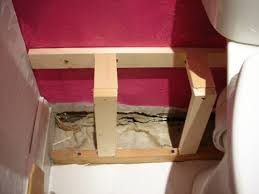 Hide pipes under a box of drywall, plywood or other sheet materials. The solution is much less labor intensive, requiring no welding or soldering of pipes, but the conduit can take up a significant amount of space if the pipes are laid sloppy or there are a lot of them.
Hide pipes under a box of drywall, plywood or other sheet materials. The solution is much less labor intensive, requiring no welding or soldering of pipes, but the conduit can take up a significant amount of space if the pipes are laid sloppy or there are a lot of them.
In practice, most often you have to use both methods at once, since not everything can be removed into the wall, water supply risers and, in particular, a sewer riser, are difficult to hide in the wall. And a modern chrome-plated heated towel rail attached to the wall will lose its appearance from the proximity to the eyeliner, so it is almost always hidden in the wall.
Which way to choose?
In order to decide how to close the pipes in the bathroom, several important circumstances should be taken into account. First of all, we must remember that nothing lasts forever, and sometimes you have to repair plumbing, fix leaks, strengthen weak welds, etc. Therefore, those sections that are planned to be hidden in the wall must be new, without defects in welding or soldering, (ideally - without joints), the cold water pipe must be waterproofed to prevent the concrete from getting wet from condensate. In addition, all communications in the bathroom have taps to plumbing and shut-off valves - valves, ball valves, to which free access must be provided.
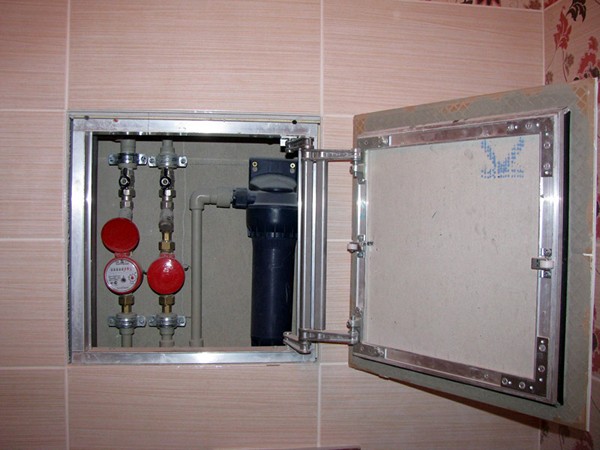 Water meters will require even more space, and besides, they must be clearly visible. All these conditions can be fully met only during construction, when it is possible to pre-design the wall in an optimal way. Ready-made wiring with installed meters and other devices can only be closed with a box, all other solutions will require dismantling and laying pipes on a new one. Therefore, the choice of a method to mask pipes is dictated by the possibilities of the premises and the expediency of performing complex work.
Water meters will require even more space, and besides, they must be clearly visible. All these conditions can be fully met only during construction, when it is possible to pre-design the wall in an optimal way. Ready-made wiring with installed meters and other devices can only be closed with a box, all other solutions will require dismantling and laying pipes on a new one. Therefore, the choice of a method to mask pipes is dictated by the possibilities of the premises and the expediency of performing complex work.
How to hide pipes in the wall
How to hide the pipes in the bathroom so that they are not visible at all?
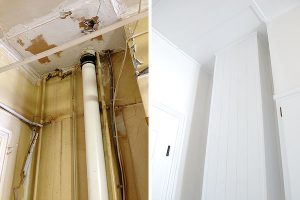 If a decision is made to wall up communications in the wall, you must first of all make sure of the quality of the connections, clarify the service life if the wiring is already in use, and, if necessary, replace everything with a new one.
If a decision is made to wall up communications in the wall, you must first of all make sure of the quality of the connections, clarify the service life if the wiring is already in use, and, if necessary, replace everything with a new one.
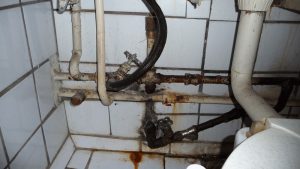 Then a channel is made in the wall - a recess in which communications will be located. Its width should allow the pipes to be freely positioned with the required distance between them, and the depth should be approximately twice the diameter.
Then a channel is made in the wall - a recess in which communications will be located. Its width should allow the pipes to be freely positioned with the required distance between them, and the depth should be approximately twice the diameter.
If the width of the channel is not very large, then it can simply be covered with tiles. If the channel is too wide, then you will first have to plaster it, after isolating the pipes from contact with concrete.
For cold water pipes, a waterproofing cut-off should be made so that condensed moisture does not penetrate into the concrete. It is best to put a special shell of porous foam on the pipe, which will prevent fogging. DHW pipes must be isolated from contact with the wall so that they do not cool down. To do this, you can use the same tubular sheath.
How to close the pipes in the bathroom with a box
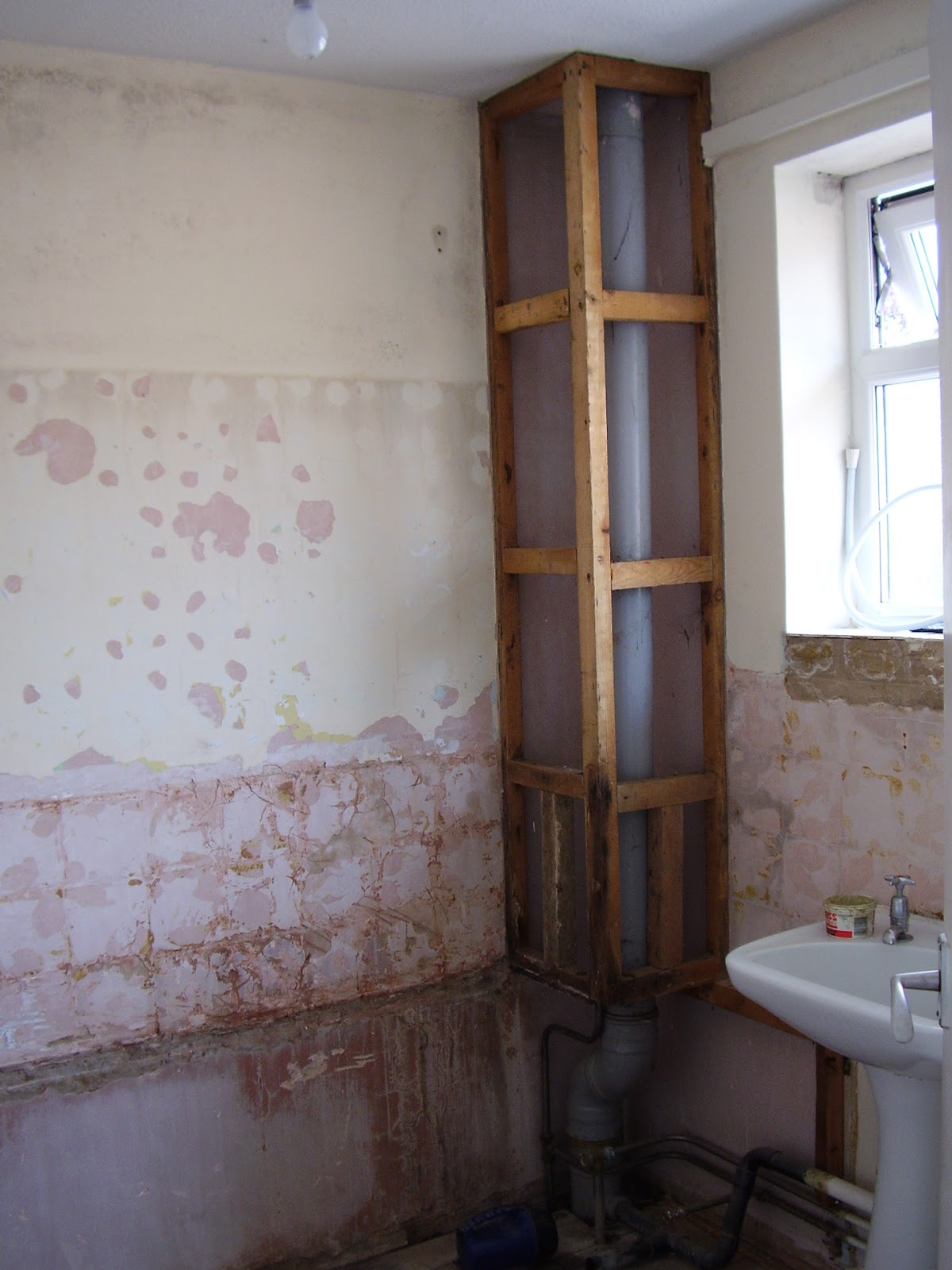 This option is much easier to perform, since only the installation of the box is required, no action is needed with the pipes themselves. In addition, this is the only possible way to disguise the sewer riser and the risers of hot water and cold water. The material for the box can be any sheet material, from drywall to plywood or chipboard.
This option is much easier to perform, since only the installation of the box is required, no action is needed with the pipes themselves. In addition, this is the only possible way to disguise the sewer riser and the risers of hot water and cold water. The material for the box can be any sheet material, from drywall to plywood or chipboard.
First, you should mark on the wall the location of the supporting elements of the future box. They can be wooden blocks, a metal profile for drywall, a mounting bracket, etc. When marking, it is necessary to take into account the thickness of the material and the finishing layer (if you plan to stick the tiles, this will add at least 1 cm of thickness).
The attachment points of the support bar are outlined, with the help of a perforator, holes are made for the dowel or anchor.
 A support bar is installed to which the entire frame of the box is attached. During the construction of the frame, it is necessary to provide an inspection hatch for taking readings from water meters and for the possibility of using shutoff valves.
A support bar is installed to which the entire frame of the box is attached. During the construction of the frame, it is necessary to provide an inspection hatch for taking readings from water meters and for the possibility of using shutoff valves.
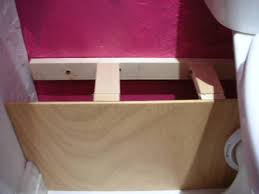 The frame is sheathed with sheet material. Finished with tiles, wall panels, paint - the choice of finishing options is wide enough, the main thing is that the properties of the finishing material allow it to be used in a bathroom.
The frame is sheathed with sheet material. Finished with tiles, wall panels, paint - the choice of finishing options is wide enough, the main thing is that the properties of the finishing material allow it to be used in a bathroom.
How to remove pipes from a heated towel rail
 When transferring or replacing a heated towel rail, pipes are most often hidden in the wall, using the method already described - a channel is cut in the wall with a grinder with a diamond disk, in which pipes with dressed insulation are installed. The main problem node is the junction of the heated towel rail. During installation, you need to pay close attention to the quality of work, and it is best to stick the tiles after a few days in order to be able to observe if there is a leak. It is possible to close the channel with tiles only if there is complete confidence in the reliability of the connections. A hidden area with an unreliable seam - the risk of flooding the neighbors from below. If the heating pipes are turned off for the summer period, you must wait until the heating season begins to check the tightness of the connections. Sometimes sections of pipes remain visible; it is easiest to paint them with white paint for heating appliances.
When transferring or replacing a heated towel rail, pipes are most often hidden in the wall, using the method already described - a channel is cut in the wall with a grinder with a diamond disk, in which pipes with dressed insulation are installed. The main problem node is the junction of the heated towel rail. During installation, you need to pay close attention to the quality of work, and it is best to stick the tiles after a few days in order to be able to observe if there is a leak. It is possible to close the channel with tiles only if there is complete confidence in the reliability of the connections. A hidden area with an unreliable seam - the risk of flooding the neighbors from below. If the heating pipes are turned off for the summer period, you must wait until the heating season begins to check the tightness of the connections. Sometimes sections of pipes remain visible; it is easiest to paint them with white paint for heating appliances.
If you do not know how to hide the pipes in the bathroom, but are determined to do it yourself, choose the easiest and least destructive option. If something goes wrong, you can always redo it without much loss.
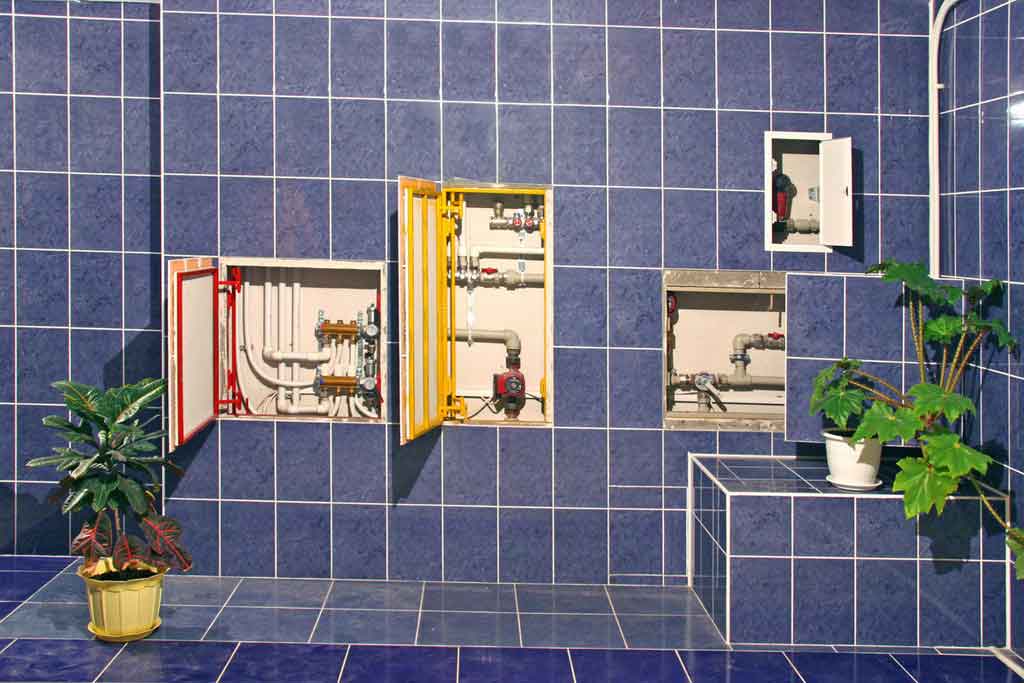 If communications are being replaced, it must be remembered that all locking elements and counters must be grouped in one place. This will provide access to all elements from one inspection hatch.
If communications are being replaced, it must be remembered that all locking elements and counters must be grouped in one place. This will provide access to all elements from one inspection hatch.
The disguised pipeline is not visible, how the connections behave is unknown, therefore those sections that will be hidden in the wall must be connected and isolated as carefully as possible.
It is quite possible to close the pipes in the bathroom on your own. This problem is completely solvable. The main thing is to decide on the way the work is done and not to overestimate your capabilities. The success of the work will depend on the accuracy and thoroughness of your actions.






